
Economic Affairs, Vol. 65, No. 3, pp. 363-370, September 2020
DOI: 10.46852/0424-2513.3.2020.7

Millet Scenario in India
ABSTRACT
Millets have high nutritional qualities and produce well under marginal conditions but they are not used to the extent that is possible. It is a number of small-grained cereal grasses and based on the grain size, millets classified as major millets and small grain millets. Major millets include sorghum and pearl millet whereas small grain millet includes finger millet, foxtail millet, kodo millet, proso millet, barnyard millet and little millet. Millets are rich in minerals and vitamins compared to rice and wheat; millets have the huge potential to provide security of food, nutrition, fodder, fiber, health, livelihood and ecology. In view of all these qualities those they so amazingly combine, millets only be called as Miracle Grains/ Nutria-Cereals. Inclusion of millet crops in a concerted way in cropping systems and also particularly in fragile ecosystems, is a virtuous move towards sustainability. Also, importance in marketing and value addition improves the millet cultivation. In this connection, the present study was carried out to examine the scenario of millets in India from 1950–51 to 2018–19 and data were collected from ministry of economics and statistics, seasonal and crop report and analysed by using compound growth rate. The growth rate of millet area and production registered negative growth i.e., area and production declining at the rate of 16.31 per cent and 13.58 per cent per year respectively. In the same way productivity was declining up to 2005 after that, it showed positive growth (3.23 per cent). Also, studied the economics of crops and observed that cost of cultivation for millet crops (sorghum and maize) compared to other important crops was lower i.e. Maize - ₹ 85915/ha, Sorghum - ₹ 47830/ha. In the same way, gross income realized by millet farmer was also low except maize crop. In India, the cost of cultivation was high in Tamil Nadu for most of the millet crop across the states due to the high human labour cost. Hence, there is a need to formulate suitable strategies considering the economic value of the crops. Therefore, the study came out with conclusion of proper cultivation practices, marketing and processing should be given to improve the millet production in India.
Highlights
 Scenario of millets in India shown an decreasing trend.
Scenario of millets in India shown an decreasing trend.
 Compared to other states cost of cultivation for millets was higher due to high labour cost in Tamil Nadu.
Compared to other states cost of cultivation for millets was higher due to high labour cost in Tamil Nadu.
 Good sign of market price for milltes.
Good sign of market price for milltes.
Keywords: Trend, millet, area, production, yield, cost
Millets are known as ancient nutritional grain and important food staples, particularly, in poor, semi-arid tropics of Asia and Africa (Mahendra, 2012 and Narloch et al. 2009) which are mostly cultivated under a variety of agro-ecological situations like plains, coast hills even diverse soil land varying rainfall. Millets are most popular in developing regions, like India and Africa, where food and nutritional security are the major challenges. The global millet production was estimated at 27.8 million ton (Mondal et al. 2016). India is the world’s leading producer of millets and has the largest global share of around 41 per cent followed by Africa. The consumption of millet in global level has declined at the rate of nearly one per cent and expected to witness positive movement during 2019–2024 (Anbukkani et al. 2017). In the last two decades, the importance of millet as food staples, in India (Michaelraj and Shanmugam, 2013b) and global level, has been declining due to demand and supply factors like rising incomes, urbanization, and government policies (King, 2017). More than 50 per cent of the millet production is currently finding its way into alternative uses as opposed to its consumption only as a staple (Uma Gowri and Chandrasekaran, 2011).
How to cite this article: Gowri, M.U. and Shivakumar, K.M. (2020). Millet Scenario in India. Economic Affairs, 65(3): 363–370.
Source of Support: None; Conflict of Interest: None 
In India, millets are mostly cultivated in Karnataka, Andhra Pradesh, Tamil Nadu, Maharashtra, Odisha, Madhya Pradesh, Rajasthan and Uttarakhand states. Rajasthan (87 per cent of Cumbu area), Maharashtra (75 per cent of sorghum area) and Karnataka (54 per cent of Ragi and 32 per cent of Cumbu) occupies maximum area of millets (Stanly and Shanmugam, 2013). Now a day, the productivity of millets is boosting through technologies and high yielding varieties. The area under small millets was decreased from the last six decades i.e. 8 million hectare (1949-50) to 1.8 million hectare (2017-18). Likewise, the production of small millet showed the same trend from 4 million ton to 2.44 million ton in the respective year, predominantly loss was occur in all other small millets compared to finger millet (Shadang and Jaganathan, 2014).
Nutrient to nutrient, every single millet is astonishingly superior to rice and wheat, therefore, is the solution for the malnutrition that affects a huge population of the India (DHAN, 2012). Nevertheless, cultivation of these millets now face many limitations/constraints resulting in decline in area cultivation of these crops, existence of high yield gaps (Uma Gowri and Prabhu, 2017), low prioritization in research agenda and subsequently less technology breakthrough in these crops. Also, public and private investments are limited to millet seed development and production (Pray and Latha, 2009). International prices for millets are highly volatile, determined largely by supply volumes, and are usually unrelated to those of other major coarse grains, such as maize, sorghum, or barley. Owing to their nutritional content, any improvements/ developments in cultivation, availability, storage, price and processing technology for millets could significantly contribute to the food and nutritional security of India’s population (Michaelraj and Shanmugam, 2013a). Further, these millets contribute in diversifying our food basket, which is at present is very narrow because of excessive dependence on major cereals like rice and wheat. This paper analyzes the scenario of millets in India and suggests suitable future strategies to revive these crops considering their economic value. The following were the major objectives of this paper;
♦ To analyze the decadal trend in area, production and productivity of millets in India;
♦ To examine the cost comparativeness of millets with other crops and across states in India; and
♦ To suggest suitable policy measures to improve millets crop cultivation in India.
METHODOLOGY
Compound growth rate (CGR)
In the present study, Compound Growth Rate (CGR) of area, production and productivity for the millets in the India were estimated to study the growth in area, production and productivity of millet crops. The Compound Growth Rates are found very convenient for any comparison of growth between two period and two crops. It seems more appreciable to analyse the movement of agricultural crops in terms of compound rather than linear growth rate (Dandekar, 1980). Hence, the compound growth rates are computed for the selected millet crops in Tamil Nadu state. The Compound Growth Rate (CGR), are usually estimated by fitting a semi-log trend equation of the form:

Where,
Yt: Area, production and yield of selected major agricultural crops in years ‘t’ respectively.
t: Year which takes value 1, 2…………. n
α & β are the parameters to be estimated, and Ɛ = random error term.
Equation (1) was estimated using Ordinary Least Squares (OLS) technique. The t-test was applied to test the significance of β. This equation is generally used on the consideration that change in agricultural output in a given year would depend upon the output in the preceding year (Chandrahekhar, 2004). Compound Growth Rate was then estimated by using the following equation:

The study considers the yearly database for the major agricultural crops to examine the growth performance of area of cultivation, production and productivity in India. The millet crops under examination included, maize, jowar, bajra and ragi for India were analyzed to predict the better growth performance. In the present study, the necessary data was collected from 1950 to 2019 was purely based on secondary sources and it was collected from various issues of statistical hand book of India and seasonal and crop report. Also, the data was gathered from the unpublished sources of department of economics and statistics, Chennai.
Cost of Cultivation
Cost of cultivation included variable and fixed costs. Variable costs included the cost of human labour, bullock power, machine power, seeds, farmyard manure, fertilizer, plant protection chemicals, irrigation charges and interest on working capital. Fixed costs comprised of depreciation, land revenue, rental value of land and interest on fixed capital.
Gross returns
Per hectare gross returns was calculated based on what the sample farmers realized actually at the market prices for the quantum of the produce in rupees.
Net return
It was calculated by taking into account gross returns subtracting the total costs.
Cost of production
This was calculated by dividing the total cost per hectare by the yield per hectare (quintal/tones/kg).
RESULTS AND DISCUSSION
(I)Growth performance of millets in India
(i) Status of millets in India: From the figure, it could be observed that, there was declining trend in area under millets of India from 51.44 lakh hectares (1950-1955) to 6.23 lakh hectares (2015-2019) and the loss of millet area was at the rate of 16.21 per cent; same way in production of millets from 21.13 lakh tons to 4.01 thousand tons and the loss was 13.58 per cent per year. In case of productivity under millets of India was declining up to 2005, and then it was increasing trend. Trend in area, production and yield of millets during the time periods from 1950-51 to 2018–19 are shown in the Table 1.
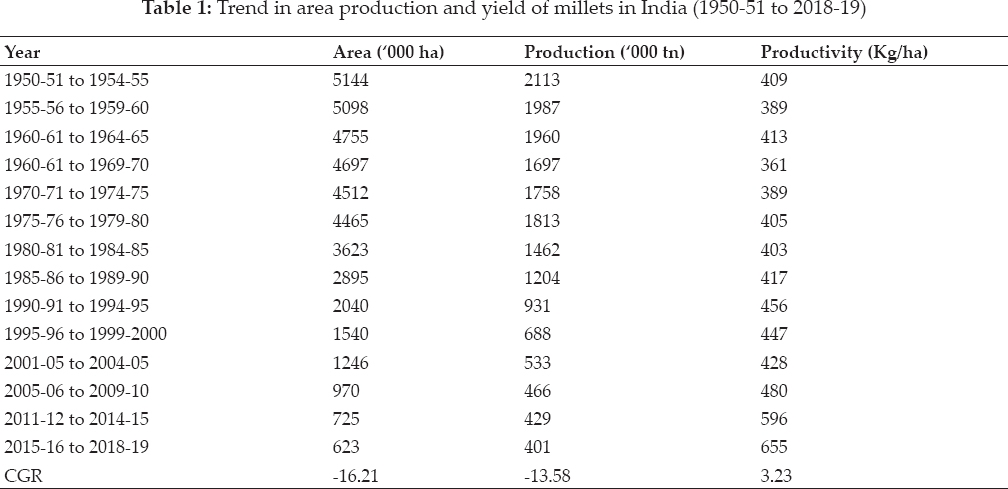
(ii) Status of small millets in India: In India small millets being cultivated an area of 6.19 lakh hectares with the production of 4.41 lakh hectares. The productivity level is 714 kg/ha. From the figure depicted that, small millets were mainly cultivated in eleven states, in that Madya Pradesh has nearly 30 per cent share in area followed by chattisgarh (14.41 per cent) and Maharastra (13.52 per cent). In the same way, production share also high (25. 57 per cent) in Madya Pradesh followed by Uttarkhand (19.23 per cent) and Maharastra (10.12 per cent). The productivity level was high in Arunachal pradesh.
(II) Cost performance of millets in India
(i) Cost comparativeness of millets with other major crops (₹/ha): The comparative cost of cultivation for major crops is depicted in table. From the table, it could be observed that cost of cultivation per hectare for millet crops (sorghum- ₹ 47820 and maize- ₹ 85915) with other important crops was lower except black gram crop. Gross income realized by maize farmer was high when it compared with paddy crop, since millets being a nutritional supplement to the poor as well as poultry farms. Market price and minimum support price was same for black gram, ground nut, cotton and sugarcane.
(ii) Cost comparativeness of major millet across states in India (₹/ha)
Sorghum: Cost of cultivation of sorghum among states inferred that the Tamil Nadu state has more cost of cultivation per hectare, it was ₹ 42957 followed by Maharashtra 40818) and Andra Pradesh 39772). Human, machine and bullock labour cost and fertilizer and manures accounted major portion in total cost of cultivation nearly 63 to 68 per cent due to industrialization in those states. In yield level Madhya Pradesh and Maharashtra stands first and second places in all India and it were 19 qtl and 12 qtl per hectare respectively. Tamil Nadu and Karnataka got only 7 qtl/ha and 6 qtl/ha respectively, since there are no improved varieties, less poor agronomic practices and value addition practices followed. Cost of production per quintal ranged from ₹ 1267 to ₹ 3885 in Madhya Pradesh and Tamil Nadu respectively. Hence, the developmental efforts should be made to enhance the production and productivity of sorghum crop and thus to reduce the cost of cultivation and to increase the income among the sorghum farmers.
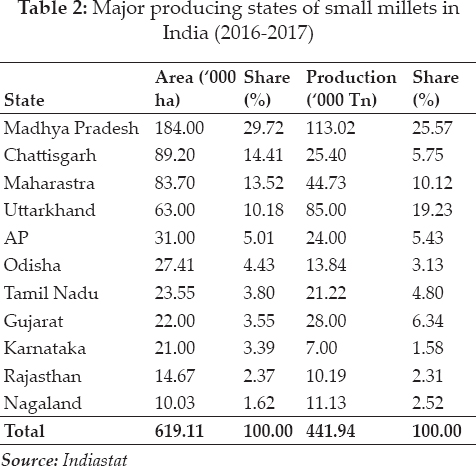
Source: Indiastat

Source: Directorate of Economics and Statistics, 2018-19.
Bajra: Bajra crop mostly cultivated in Gujarat, Haryana, Maharashtra, Rajasthan and Utter Pradesh states in India. In these states, cost of cultivation was high in Maharashtra 52311/ha) followed by Gujarat 48281/ha) state. But the yield level was high in UP and Gujarat and it were 29 qtl and 24 qtl per hectare respectively. In total cost of cultivation, major share occupied by human labour which accounts nearly 30–35 per cent, followed by fertilizer and manures, it was 12–15 per cent across the states of India. Since Gujarat is a drought region, irrigation charges for cultivation of bajra occupies 13 per cent of cost of cultivation. Cost of production per quintal was ranged from ₹ 1117 to ₹ 1963 in India.
Maize: Maize is one of the most important millet crop and it mostly cultivated in nine states. Cost of cultivation of maize was more in Tamil Nadu state 92710/ha) followed by Maharashtra 72873/ha) and Andhra Pradesh 67285/ha). The major share of cultivation was occupied by human labour, fertilizer and manures and machine labour, which accounted 46–67 per cent among the states. Seed cost was occupied by nearly 10 per cent of the total cost of cultivation. The yield level was high in Maharashtra followed by AP. Cost of production per quintal of maize was ranged from ₹ 1134 to ₹ 1981 across the states in India.
Farmers are moving from millet crops to other cereal and cash crops mainly to earn more income even though millets are drought resistant and rich in nutrients. Like new technology and new variety may break through the increase the area under millets and can increase the production. Varietal improvements and yield gap are the major concern for increase in production of millets.
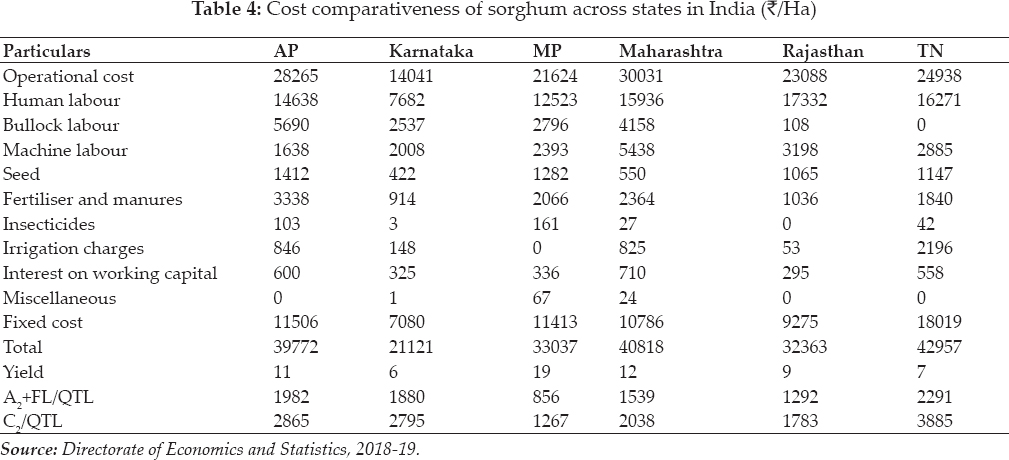
Source: Directorate of Economics and Statistics, 2018-19.
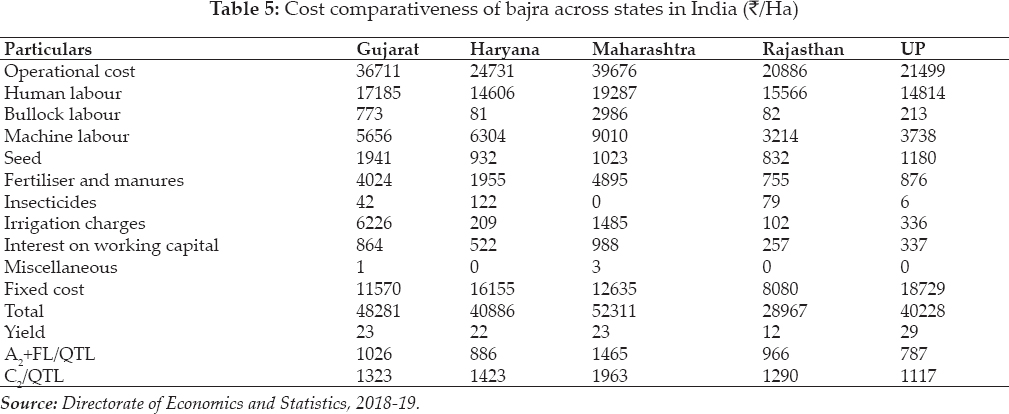
Source: Directorate of Economics and Statistics, 2018-19.

Source: Directorate of Economics and Statistics, 2018-19.
Note: A2 - Actual paid out cash; A2 +FL - Actual paid out cost plus imputed value of family labour; C2 - Comprehensive cost including rental value of own land (Net of land revenue) and interest on value of own fixed capital assets (excluding land).
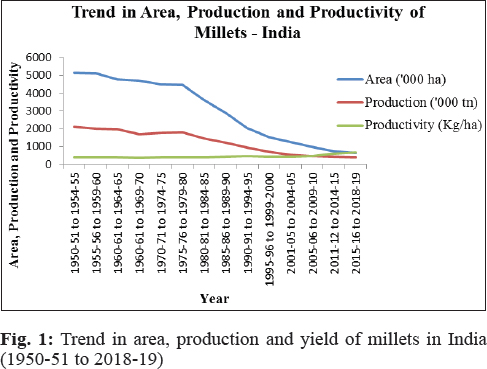
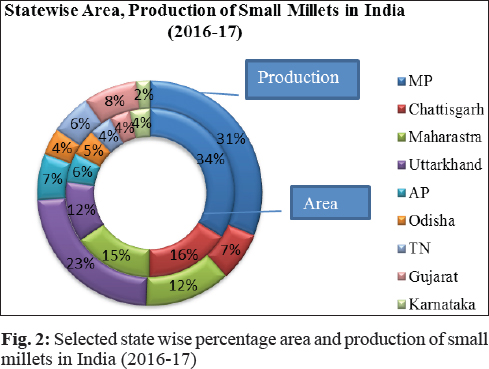
iii) Comparison of Millet Market price with Minimum Support Price
Maize is an important millet crop, but market prices were below Minimum Support Price (MSP) in 2014–15 and 2017–18, for ragi it were 2010–11, 2016-17 and 2018–19 (Fig. 3). However, the gap between MSP and market prices narrowed down in 2018–19 as compared to 2017–18. In 2018–19, it was observed that market prices steadily increased during October 2018 to January 2019, showing a good sign of convergence with MSP. The increased production seems to be making a dent on the market prices of maize. It is important to reduce cost of cultivation and improve yield to increase profitability. In order to reduce cost of cultivation of reduce irrigation water requirement as compared to conventional tillage system and improve water and nutrient productivity as well (Price Policy, 2018–19). In case of sorghum crop, market price was higher than MSP in above periods.
Strategies to retrieving millets
Millets known as climate resilient crops since it is drought tolerant and thus it could provide future food and farming secure in India. Millets are rich in minerals, micronutrients and vitamins compared to other cereals like rice, wheat. To enhance the nutritive value of millets, it supplied through public distribution system (PDS), new meal scheme, ICDS and other welfare hostel program can be strengthened.
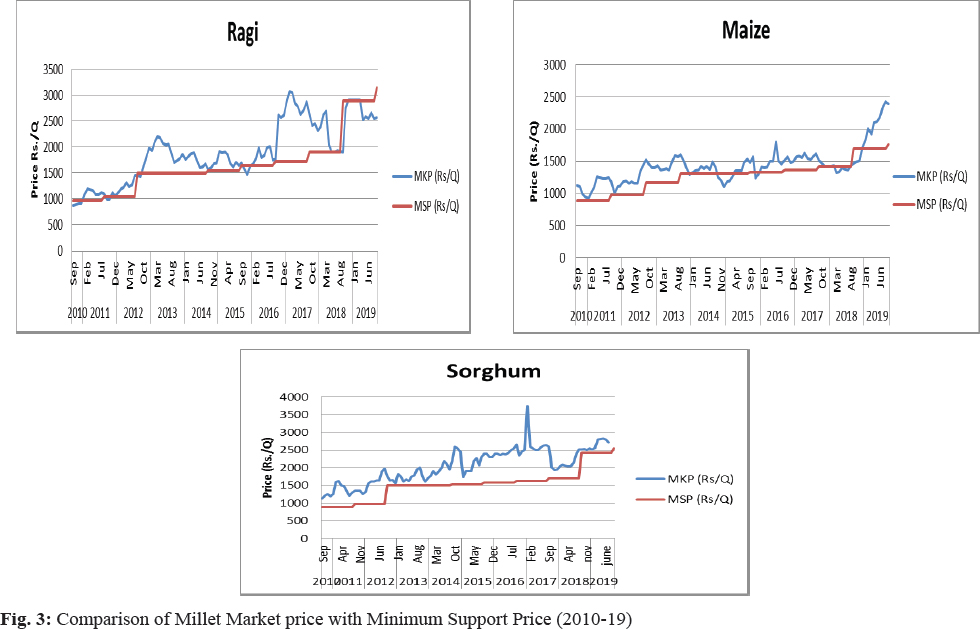
The area under millet is shrinking since it is traditionally cultivated in dry land by small and marginal farmers also tribal communities. Also, the cultivation of millets relays on productivity, labour availability, post harvest operations and farm gate price. It will be promoted through government programmes like INSIMP, NFSM, RADP, RKVY.
Millets are amazing capacity of production without using ground water/surface irrigation, fertilizer, pesticide etc. Hence it must be honored through socio ecological bonus to millet farmers. Also, insurance and institutional finance should be offered to millet farmers.
Difficult processing is the key challenge that hinders consumer demand and upscaling potential for minor millets. Several interventions can be made to facilitate access by value chain actors to processing plants on the one end and by consumers to processed millet products on the other.
Finally, research institution must give a new thrust on millet area and issue.
CONCLUSION
The preceding analysis on the trend in area under millets showed that there is a gradual decline. As millets are predominantly grown in marginal and sub marginal dry lands by poor farmers, the fluctuations in area, production and productivity not only bring hardship to farmers but also could create instability. Considering the economic significance of the crops, developmental efforts should be made through demonstrations and training programmes and thus popularizing the cultivation and processing of these crops. The gradual decline in net availability of cereals and the trend is more towards consumption of rice and wheat i.e. the consumer dietary cereals are being slowly replaced by major cereals like rice and wheat. This is the perspective from which the millet cultivation and its promotion must be regarded.
ACKNOWLEDGEMENTS
The first author is thankful to the Indian Council of Social Science Research (ICSSR), New Delhi, India for the financial support provided to the research entitled Value Chain Analysis of Millets in Western Tamil Nadu under the ICSSR-Post Doctoral Fellowship.
REFERENCES
Dandekar, V.M. 1980. Introduction to seminar on data and methodology for the study of growth rates in agriculture.
DHAN Foundation 2012. Supporting millets in India: policy review and suggestions for action.
Food and Agriculture Organization 2010. Agricultural biodiversity, multifunctional character of agriculture and land conference,
Government of Tamil Nadu 2013. Season and crop report 2011–12, Department of Economics and Statistics, Chennai.
King EDIO, 2017. Impact of Reduced drudgery of women in production and post-harvest processing of small millets,
Mahendra Dev, S. 2012. Small farmers in India: challenges and opportunities.
Michaelraj, P.S.J. and Shanmugam, A. 2013a. A study on millets cultivation in Karur district of Tamil Nadu.
Michaelraj, P.S.J. and Shanmugam, A. 2013b. A study on millets based cultivation and consumption in India.
Mondal, A., King, I.O., Roy, S., Priyam, S., Meldrum, G., Padulosi, S. and Mishra, S. 2016. Making millets matter in Madhya Pradesh.
Narloch, U., Drucker, A.G. and Pascual, U. 2011. Payments for agro-biodiversity conservation services for the sustained on-farm utilization of plant and animal genetic resources.
Narloch, U., Unai, P., Adam, G. and Drucker, 2009. Payments for agrobiodiversity conservation services (PACS): Creating incentive mechanisms for the sustained on-farm utilization of plant and animal genetic resources,
Nautiyal, S. and Kaechele. 2006. Traditional crop diversity needs institutional and policy support for their conservation and sustainable land use development in Himalayas of India.
Padulosi, S. Bhag Mal O. I. King and E, 2015. Gotor, Minor Millets as a Central Element for Sustainably Enhanced Incomes, Empowerment, and Nutrition in Rural India.
Pray, C.E. and Nagarajan, L. 2009. Pearl millet and sorghum improvement in India.
Raghavendra, K.T., Chakravarthy, A.K. and Basavaraju, B.S. 2010. Agro biodiversity insole and mixed field bean agro systems in South Karnataka. Lake: Wetlands, Biodiversity and Climate Change, pp. 1–8.
Rajshekar, S.C. and Raju, S. 2017. Introduction of millets in PDS- Lessons from Karnataka.
Stanly, J.M. and Shanmugam. 2013. A study on millet based cultivation and consumption in India.
Uma Gowri, M. and Chandrasekaran, M. 2011. An Economic Analysis of Value Chain of Banana in Western Tamil Nadu.
Uma Gowri, M. and Prabhu, R. 2017. Millet Production and Its Scope for Revival in India with special reference to Tamil Nadu.